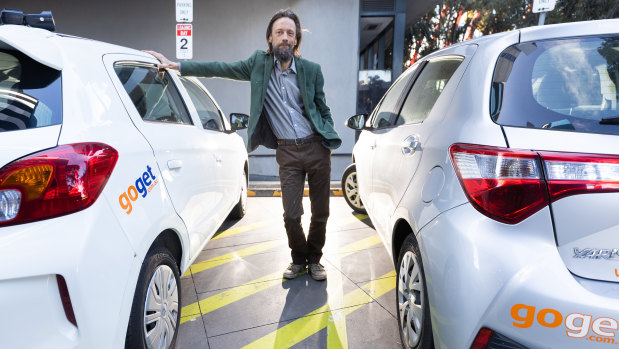Car sharing is on the rise in Melbourne. Is it for you?

Six years ago, Flemington resident Adam Ford happily rid himself of what he called his “big metal box” (a Ford Focus hatchback) and switched to using car share instead.
“I did my research, summed up the costs initially and just figured it was certainly something I wasn’t going to have a net loss from,” said the 49-year-old marketer.
Car share apps are booming during the cost of living crisis, with some posting a 300 per cent increase in users, like Adam Ford, in Melbourne during the past year alone.Credit:Jason South
Ford has quick access to half a dozen vehicles within a 10-minute walk of his home, including a van. He only needs a car once or twice a month due to living near two tram and train lines, and he’s happy to help take an extra car off his street.
Melburnians on average spent $461.01 a week on transport costs, according to data from the Australian Automobile Association, only $46 of which is for public transport. The rest takes in the costs of car loan payments, fuel, tolls, insurance, registration, car and tyre servicing and roadside assist.
As these costs have surged, more and more Victorians have taken up car sharing: a model of hire cars where residents pay per hour to access a car parked in their local community. Membership gives you swipe-card access to the car, which can be booked online via an app, and fuel is covered in the per-hour fee.
The largest provider, GoGet, which has almost 1000 cars in metropolitan Melbourne, has 30 per cent more users than before the COVID-19 pandemic. Flexicar, which operates 300 vehicles across the state, is also up 30 per cent.
Popcar, which operates 64 vehicles in the metropolitan area, has tripled its users in the past year, while users of Green Share Car, which has 25 on-street cars and several in strata buildings, are up 20 per cent on pre-pandemic levels. New market entrant Kinto launched in March 2021 and now has 109 vehicles on Melbourne’s streets.
‘Peer sharing’ company Car Next Door, which allows car owners to rent their under-utilised cars out by the hour to their neighbours, has seen a 150 per cent increase in Victorian cars listed, and a 97 per cent increase in borrower sign-ups.
Car sharing, however, does have its downsides: there’s no guarantee of availability within walking distance of your home, people can return cars late or without fuel, you may need to book a vehicle days in advance, and there’s the logistical headache if you’re caught in an accident or cop a speeding fine. Analysis by consumer advocacy outfit Choice in 2015 showed car share schemes were only more economical for drivers who drove less than 5000km a year, or around 400km a month on average.
Knowles Tivendale, the managing director of transport consultancy firm Movement and Place, said increased car sharing could have a big impact on local streets.
“We know that each car share vehicle in an inner-city frees up about eight car spaces on one street,” he said.
Despite the increase in demand, car use expert Elizabeth Taylor – a senior lecturer in urban planning and design at Monash University – said car share coverage was still “incredibly uneven” across the city and the state.
“In terms of where the car share operators go, and where there’s policy to support it, it is really ad hoc,” Taylor said.
Only a third of Melbourne’s 33 metropolitan council areas have car share policies: City of Melbourne, Port Phillip, Stonnington, Boroondara, Darebin, Glen Eira, Maribyrnong, Moreland, Yarra, Greater Dandenong and Kingston.
Tivendale, who consults for local councils, said there was plenty more growth possible in the car share market if councils and businesses committed to swapping fleet vehicles for car share memberships for staff. This would guarantee car share operators enough demand to install a car, and businesses could dedicate their existing car spots to the scheme.
“It could be any company in a regional or metro area – public or private with any scale – even a real estate agent. They would all be in with the potential to generate savings for their own business and then be the base load of demand that would support the service being available for residents around the area to use them too,” he said.
He said car share operators should also market to families as an alternative to a “second and third car”, instead of just targeting inner-city types without a vehicle.
While Adam Ford is happy enough with car sharing, and won’t be buying a car again any time soon, he does want to see improvements in coverage and more flexibility of models.
“I work from home. I have a little marketing business and often I’m doing client visits, spending half an hour travelling out there,” he said. “You pay by the hour and so if the car sits in a car park for three or four hours, you’re paying for it to sit there.
“What’s needed is a system where I can book it for an hour to get to, say, Camberwell, and return it to a bay there, then hire another one when I need to get home.
“Sometimes, [doing] the cost comparison for these individual visits, I think ‘I should I have just got a taxi’.”
The Morning Edition newsletter is our guide to the day’s most important and interesting stories, analysis and insights. Sign up here.
Most Viewed in National
From our partners
Source: Read Full Article
